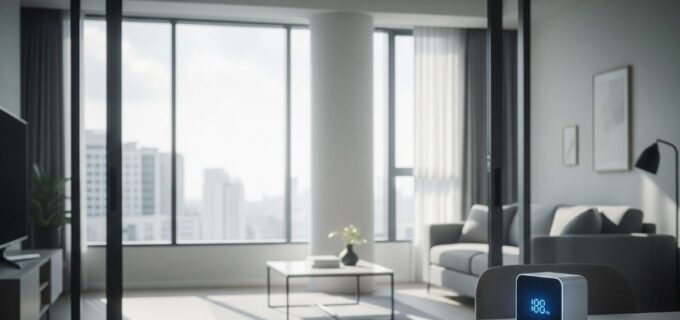Picture this: You’re nestled in your sleek Singapore apartment, a sanctuary from the city’s vibrant chaos. The air conditioner hums softly, keeping the tropical heat at bay. You take a deep breath, savouring the cool air. But what if that breath carried an invisible threat?
Welcome to the world of formaldehyde where this chameleon-like compound lurks in the shadows of our urban cocoons, shape-shifting from the wood of your stylish IKEA bookshelf to the fabric of your prized curtains. In Singapore’s concrete jungle, where we’ve mastered the art of indoor living, this sneaky pollutant has found its paradise.
But why should you care about a chemical you can’t see or touch? Imagine formaldehyde as the party crasher which mingles with your indoor air, growing bolder as Singapore’s infamous humidity eggs it on. Before you know it, this uninvited guest could be overstaying its welcome, potentially turning your pristine apartment into a hotbed of headaches, irritations, and long-term health concerns.
Ironically, the city known for its spotless streets and green initiatives has crafted perfect incubators for formaldehyde. Our tightly sealed, energy-efficient buildings – a testament to our eco-conscious mindset – can inadvertently trap this volatile troublemaker, allowing it to build up to levels that would make even the hardiest nose wrinkle.
In this article, we’ll dive into the thrilling world of indoor air quality testing in Singapore. We’ll unmask the sources of formaldehyde, decode its health-impacting mysteries, and reveal how regular IAQ testing can be your secret weapon in keeping this chemical gatecrasher in check.
Understanding Formaldehyde and Its Sources
What is Formaldehyde?
Formaldehyde is a colourless, strong-smelling gas commonly found in many building materials and household products. Due to its widespread use, formaldehyde is a prevalent indoor pollutant that can have serious health implications. Short-term exposure to formaldehyde can cause symptoms such as irritation of the eyes, nose, and throat, as well as coughing, wheezing, and skin rashes. Long-term exposure, even at low levels, has been linked to more severe health issues, including respiratory problems and an increased risk of cancer, particularly nasopharyngeal cancer and leukaemia.
Common Sources of Formaldehyde in Homes and Offices
Formaldehyde can be found in a variety of products and materials commonly used in both residential and commercial settings.
Building Materials
Pressed wood products like particleboard, plywood, and fiberboard are major sources of formaldehyde because they often contain adhesives made with urea-formaldehyde (UF) resins. These materials are widely used in furniture, cabinetry, and flooring. Insulation materials, particularly those made with UF foam, also release formaldehyde over time.
Furnishings and Décor
Many types of carpets, upholstery, and curtains can emit formaldehyde, especially when new. The chemical is used in fabric treatments to make them more durable and wrinkle-resistant. Additionally, some types of wallpaper and paints, particularly those labelled as “low-VOC” rather than “no-VOC,” can also release formaldehyde.
Household and Office Products
Formaldehyde is commonly found in a range of household and office products, including cleaning agents, adhesives, glues, and certain types of paper products. Even cosmetics and personal care products, such as nail polish and hair treatments, can contain formaldehyde or formaldehyde-releasing preservatives.
Factors Contributing to Formaldehyde Buildup
Several factors can contribute to the accumulation of formaldehyde in indoor environments, particularly in Singapore’s climate.
Poor Ventilation and Air Circulation
Inadequate ventilation allows formaldehyde to build up over time. Modern buildings, which are often well-sealed to improve energy efficiency, can trap pollutants indoors. Without proper ventilation, the concentration of formaldehyde and other VOCs can reach unhealthy levels.
High Indoor Temperatures and Humidity Levels
Singapore’s tropical climate, characterised by high temperatures and humidity, can exacerbate the release of formaldehyde from building materials and furnishings. Heat accelerates the off-gassing process, while humidity increases the rate at which formaldehyde is released into the air. This makes regular monitoring and mitigation efforts particularly important in this environment.
The Importance of Regular Indoor Air Quality (IAQ) Testing
Identifying and Measuring Formaldehyde Levels
Regular IAQ testing is crucial for identifying and quantifying the levels of formaldehyde and other pollutants in indoor environments. There are various types of IAQ tests available, ranging from basic air sampling kits to advanced, professional-grade monitoring systems.
Types of IAQ Tests Available
Simple, do-it-yourself test kits can provide a basic snapshot of formaldehyde levels. However, for more accurate and comprehensive results, professional IAQ assessments are recommended. These assessments often involve the use of specialised equipment that can detect and measure a wide range of VOCs, including formaldehyde, at very low concentrations.
How Formaldehyde Levels are Detected and Measured
Formaldehyde levels are typically measured in parts per million (ppm) or micrograms per cubic metre (µg/m³). Testing involves collecting air samples from different areas of a home or office over a period of time, which are then analysed in a lab to determine the concentration of formaldehyde present. Regular testing helps establish a baseline for air quality and identifies any changes over time, which can be crucial for early detection of potential problems.
Benefits of Regular IAQ Testing
Regular IAQ testing offers several important benefits that contribute to the health and well-being of occupants in homes and offices.
Early Detection of Harmful Pollutants
One of the primary benefits of regular IAQ testing is the early detection of harmful pollutants like formaldehyde. Early detection allows for timely intervention, preventing the buildup of dangerous levels of these pollutants and reducing the risk of health problems associated with long-term exposure.
Ensuring Compliance with Safety Standards and Regulations
In Singapore, there are guidelines and regulations concerning acceptable levels of indoor air pollutants, including formaldehyde. Regular IAQ testing helps ensure that homes and offices comply with these standards, protecting occupants from exposure to unsafe levels of pollutants.
Peace of Mind for Residents and Employees
Knowing that the air quality in your home or workplace is being regularly monitored provides peace of mind. It reassures residents and employees that their environment is safe and that steps are being taken to protect their health.
How Regular IAQ Testing Helps Prevent Formaldehyde Buildup
Timely Identification of Potential Sources of Formaldehyde
Regular IAQ testing is instrumental in identifying new or previously unnoticed sources of formaldehyde within indoor environments.
Detecting New Sources from Recent Renovations or New Furniture
Renovations, new furniture, and other updates to a home or office can introduce new sources of formaldehyde. Regular IAQ testing can detect these changes early, allowing for prompt mitigation before the formaldehyde levels become problematic.
Monitoring Changes in IRAQ Over Time
Over time, the effectiveness of ventilation systems can decrease, or new sources of pollutants can emerge. Regular testing allows for continuous monitoring of indoor air quality, ensuring that any increases in formaldehyde levels are identified and addressed quickly.
Implementing Effective Mitigation Strategies
Once formaldehyde is detected, there are several strategies that can be implemented to reduce its levels and prevent further buildup.
Improving Ventilation and Air Filtration Systems
Enhancing ventilation is one of the most effective ways to reduce formaldehyde levels. This can involve increasing natural ventilation by opening windows and doors, or improving mechanical ventilation systems to ensure adequate air exchange. High-efficiency particulate air (HEPA) filters and air purifiers can also help remove formaldehyde from the air.
Using Formaldehyde-Free Products and Materials
Choosing building materials, furnishings, and products that are labelled as formaldehyde-free or low-formaldehyde can significantly reduce the introduction of this pollutant into indoor environments. Consumers and businesses should be aware of the potential for formaldehyde emissions and opt for safer alternatives when possible.
Regular Maintenance and Cleaning Practices
Regular maintenance of HVAC systems and consistent cleaning practices can help reduce the accumulation of formaldehyde and other pollutants. This includes regularly replacing air filters, ensuring ducts and vents are clean, and using cleaning products that do not contain formaldehyde.
Case Studies or Examples of Successful Formaldehyde Management Through IAQ Testing
Office Environment Case Study
A company in Singapore noticed a decline in employee productivity and an increase in sick leave. IAQ testing revealed that new office furniture was emitting high levels of formaldehyde. The company took action by upgrading their ventilation system, implementing regular IAQ monitoring, and educating employees on the importance of good indoor air quality. As a result, employee health and productivity improved.
The Role of Professionals in IAQ Testing and Formaldehyde Management
Importance of Hiring Certified IAQ Professionals
When it comes to IAQ testing and formaldehyde management, the expertise of certified professionals is invaluable.
Expertise in Identifying and Addressing IAQ Issues
Certified IAQ professionals have the training and experience needed to accurately assess indoor air quality and identify sources of pollution. They can provide detailed reports and recommendations tailored to the specific needs of a home or office.
Use of Advanced Testing Equipment and Techniques
Professionals have access to advanced testing equipment that can detect even low levels of formaldehyde and other pollutants. Their ability to use these tools effectively ensures accurate and reliable results, which are crucial for making informed decisions about air quality management.
Professional Guidance on Improving Indoor Air Quality
Beyond testing, IAQ professionals offer valuable guidance on how to maintain and improve indoor air quality.
Tailored Recommendations Based on Test Results
After conducting an IAQ test, professionals can provide customised recommendations on how to reduce formaldehyde levels and improve overall air quality. This might include specific ventilation improvements, product substitutions, or changes to cleaning practices.
Long-Term Monitoring and Maintenance Plans
Professionals can help establish a long-term plan for monitoring and maintaining indoor air quality. This can include setting up regular testing schedules, ongoing maintenance of ventilation systems, and periodic reviews of IAQ management strategies.
Educating Residents and Employees About Formaldehyde Risks and Prevention
Education is a critical component of effective IAQ management. Professionals can help raise awareness about the risks of formaldehyde and other pollutants.
Workshops, Seminars, and Informational Resources
IAQ professionals often offer workshops and seminars to educate residents and employees about indoor air quality. These sessions can provide practical tips on reducing exposure to formaldehyde and other pollutants and emphasise the importance of regular IAQ testing.
Promoting Awareness and Proactive IAQ Management
By promoting awareness, professionals encourage proactive IAQ management. When residents and employees understand the risks and how to mitigate them, they are more likely to take action to maintain a healthy indoor environment.
Practical Tips for Homeowners and Office Managers
Simple Steps to Reduce Formaldehyde Exposure
There are several straightforward steps that homeowners and office managers can take to reduce exposure to formaldehyde.
Choosing Low-Formaldehyde or Formaldehyde-Free Products
When purchasing building materials, furniture, or cleaning products, opt for those labelled as low-formaldehyde or formaldehyde-free. These products are designed to minimise or eliminate formaldehyde emissions, making them safer for indoor use.
Regularly Airing Out Indoor Spaces
Regularly airing out your home or office can help reduce formaldehyde levels. Open windows and doors to allow fresh air to circulate, particularly after using products that may contain formaldehyde or after bringing new furniture or building materials into the space.
Setting Up a Routine IAQ Testing Schedule
Establishing a routine IAQ testing schedule is essential for maintaining good indoor air quality.
Frequency of Tests Based on Environmental Factors and Building Use
The frequency of IAQ testing should be determined by factors such as the age of the building, recent renovations, the use of formaldehyde-containing products, and the number of occupants. High-risk environments may require more frequent testing to ensure that formaldehyde levels remain within safe limits.
Incorporating IAQ Testing into Property Maintenance Routines
IAQ testing should be integrated into regular property maintenance routines. By making it a standard practice, homeowners and office managers can stay on top of potential air quality issues and address them before they become serious problems.
Responding to IAQ Test Results
How you respond to IAQ test results is crucial in preventing formaldehyde buildup.
Immediate Actions to Take if High Formaldehyde Levels Are Detected
If IAQ testing reveals high formaldehyde levels, take immediate action to mitigate the risks. This might include increasing ventilation, removing or replacing sources of formaldehyde, and consulting with IAQ professionals for further guidance.
Ongoing Monitoring and Adjustments to Maintain Safe IAQ
Even after taking corrective measures, it’s important to continue monitoring indoor air quality. Regular IAQ testing and adjustments to your management strategies will help maintain safe air quality and protect the health of occupants.
IAQ Testing Singapore: Prevent Formaldehyde & Ensure a Healthy Home
Maintaining good indoor air quality is vital for the health and well-being of residents and employees in Singapore. Regular IAQ testing plays a critical role in preventing the buildup of harmful pollutants like formaldehyde, ensuring that indoor environments remain safe and comfortable.
By understanding the sources of formaldehyde, implementing effective mitigation strategies, and working with certified IAQ professionals, you can significantly reduce the risks associated with formaldehyde exposure. Proactive IAQ management not only protects physical health but also provides peace of mind, knowing that your indoor environment is being carefully monitored and maintained.
By embracing IAQ testing, we’re not just ticking a box on our checklist, we’re taking a proactive stance in a very Singaporean way – efficiently and effectively tackling a problem before it becomes a crisis. It’s like having a sophisticated NEA officer for your home or office, constantly on the lookout for troublemakers like formaldehyde.
In embracing regular IAQ testing, we’re not just protecting our physical health. We’re cultivating peace of mind – a precious commodity in our fast-paced city. It’s knowing that while you’re out enjoying your chicken rice or closing that big business deal, your indoor space is being looked after with the same dedication that keeps our Changi Airport running like clockwork.




